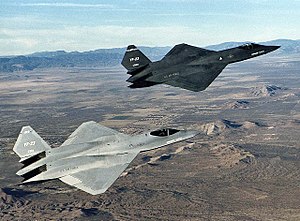Northrop YF-23
| YF-23 | |
|---|---|
 |
|
| YF-23, nicknamed Gray Ghost (foreground), flying with YF-23 Black Widow II | |
| Role | Stealth fighter technology demonstrator |
| National origin | United States |
| Manufacturer | Northrop/McDonnell Douglas |
| First flight | 27 August 1990 |
| Status | Canceled |
| Primary user | United States Air Force |
| Produced | 1989–90 |
| Number built | 2 |
The Northrop/McDonnell Douglas YF-23 was an American single-seat, twin-engine stealth fighter aircraft technology demonstrator designed for the United States Air Force (USAF). The design was a finalist in the USAF's Advanced Tactical Fighter (ATF) competition, battling the Lockheed YF-22 for a production contract. Two YF-23 prototypes were built with the nicknames "Black Widow II" and "Gray Ghost".
In the 1980s, the USAF began looking for a replacement for its fighter aircraft, especially to counter the USSR's advanced Sukhoi Su-27 and Mikoyan MiG-29. Several companies submitted design proposals; the USAF selected proposals from Northrop and Lockheed. Northrop teamed with McDonnell Douglas to develop the YF-23, while Lockheed, Boeing and General Dynamics developed the YF-22.
The YF-23 was stealthier and faster, but less agile than its competitor. After a four-year development and evaluation process, the YF-22 was announced the winner in 1991 and entered production as the Lockheed Martin F-22 Raptor. The U.S. Navy considered using the production version of the ATF as the basis for a replacement to the F-14, but these plans were later canceled. The two YF-23 prototypes were museum exhibits as of 2010.
American reconnaissance satellites first spotted the advanced Soviet Su-27 and MiG-29 fighter prototypes in 1978, which caused concern in the U.S. Both Soviet models were expected to reduce the maneuverability advantage of contemporary US fighter aircraft. In 1981, the USAF requested information from several aerospace companies on possible features for an Advanced Tactical Fighter (ATF) to replace the F-15 Eagle. After discussions with aerospace companies, the USAF made air-to-air combat the primary role for the ATF. The ATF was to take advantage of emerging technologies, including composite materials, lightweight alloys, advanced flight-control systems, more powerful propulsion systems, and stealth technology. In October 1985, the USAF issued a request for proposal (RFP) to several aircraft manufacturers. The RFP was modified in May 1986 to include evaluation of prototype air vehicles from the two finalists. At the same time, the U.S. Navy, under the Navalized Advanced Tactical Fighter (NATF) program, announced that it would use a derivative of the ATF winner to replace its F-14 Tomcat. The NATF program called for procurement of 546 aircraft along with the USAF's planned procurement of 750 aircraft.
...
Wikipedia
